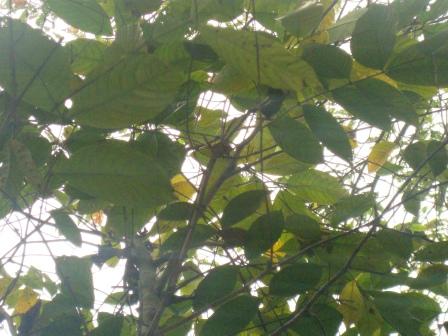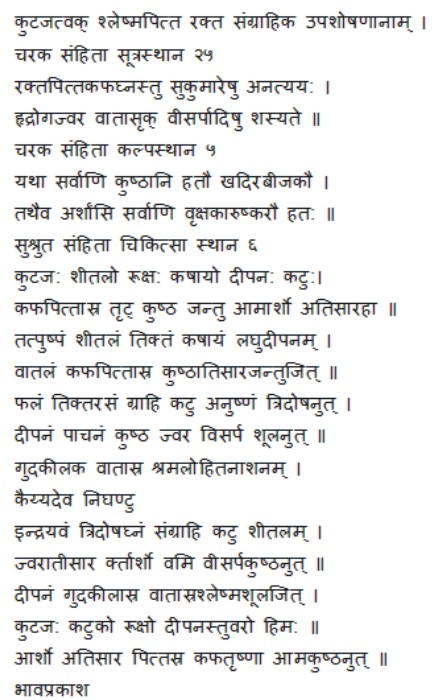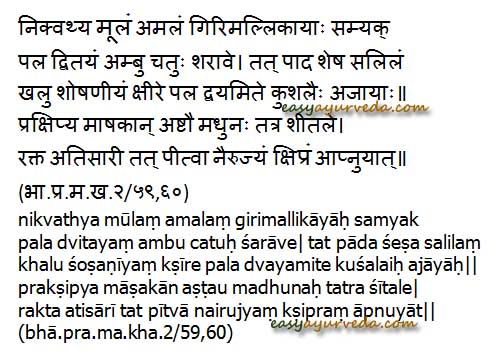Kutaja – Benefits, Usage, Dose, Side Effects – Ayurveda Details
Kutaja is a very famous herb used in treating diarrhea, irritable bowel syndrome etc. It is used in preparing very common Ayurveda medicines like Kutajarishta, Kutaj Ghanavati etc.

Botanical Name – Holarrhena antidysenterica, Wrightia antidysenterica
Family – APOCYANACEAE (Kutaja Kula)
Table of Contents
Medicinal qualities
Rasa (taste) – Tikta (bitter), Kashaya (Astringent)
Guna (qualities) – Laghu (lightness), Rooksha (dryness)
Veerya – Sheeta – cold potency
Vipaka – Katu – Undergoes pungent taste conversion after digestion.
Effect on Tridosha – It balances Kapha and Pitta.
According to Bhojana Kuthalam, Kalinga is sweet in taste, cold in potency, treats burning sensation, aggravation of pitta dosha and fatigue. It is aphrodisiac, nourishes and strengthens the dathus, promotes virility and nutrition.
Part used, dosage
Parts Used – Bark, leaves, seeds, flowers.
Kutaja seeds are called Indrayava. Wherever in Ayurveda textbooks, Indrayava is mentioned, there Kutaja seeds are taken as ingredients.
Dosage – Powder 3-6 grams in a divided dose in a day is the maximum dose.
Its water decoction (Kashaya) is given in a dose of 50 – 100 ml per day.
Home remedies
Written by Dr MS Krishnamurthy MD (Ayu), PhD
Diarrhea
1. Kutaja remedy for diarrhea, dysentery and IBS:
The bark of the stem is taken and its decoction is made. This decoction is administered in the dose of 20-30 ml three or four times a day. This effectively controls diarrhea, dysentery, IBS etc.
Ulcerative colitis, worms
2. Kutaj and bael remedy for ulcerative colitis and intestinal worms:
Equal amounts of Kutaja bark and Bael leaves are taken and its decoction is made. This decoction if administered regularly pacifies intestinal worms and ulcerative colitis and simple colic abdomen too. During the medicatio, buttermilk is administered as Anupana.
Debility, dyspepsia
3. Kutaj dried flower soup as appetizer in post fever debility and dyspepsia:
The flowers are dried under sun shade. It is fried with little ghee or oil by sprinkling a little salt water. This can be used as it is. Or else to this, water and a pinch pepper is added and cooked for 5 minutes. This soup is useful for anorexia, tiredness caused due to fever and diarrhea.
Evening rise of temperature
4. Kutaj seed powder, cumin and fennel remedy for evening rise of temperature:
Kutaja seed, cumin seeds and fennel seeds are taken in equal amounts and made into powder. To this 10 grams of powder 200 ml hot water is added and allowed for cooling. When it is lukewarm this is taken in the dose of 30-40 ml twice or thrice a day. This relieves the evening rise in temperature.
Fever, food poisoning
5. Kutaj bark decoction for recurrent fever and food poisoning:
Dry bark of Kutaja plant is used to prepare the decoction. This decoction helps to relieve recurrent attacks of fever, complications of food poisoning etc. In allergic skin manifestations (of children) also this is effective.
Ulcers
Root or stem powder of the plant is used to dust over the oozing ulcers. This relieves the secretion and helps to ease the processing of healing.
Kutaja is a very safe and effective medicine which takes care of fever, diarrhea, indigestion, IBS, hemorrhoids, food poisoning etc. Preferably its decoction or hot infusion helps to manage the above said complaint to the best possible extent. Many times it acts as an emergency medicine as well.
The practitioners appreciate its good benefits in the cases of loose motion which is not pacified by any of the antidiarrheals and anti-biotics/microbial are benefited by Kutaja derived formulations like Kutajarishtha, Kutajavaleha, Kutajamustakadi kashaya etc.
Click to consult Dr MS Krishnamurthy MD (Ayu), PhD
Research on Kutaja
It is bitterly associated with astringent in taste and cooling herb, possessing pungent bio transformation(vipaka) effect. It balances Pitta and Kapha Dosha.
Excess intake or over dosage of the formulations containing Kutaja may provoke Vata dosha.
The stem bark, root bark and seeds are the usable parts of this plant.
are unique Ayurvedic medicines of this herb.
The bark is a rich resource of tannin contents followed by the alkaloids such as conessine, conimine, conkurchine group alkaloids including conessidine and holarrhenine, holafrine, holarrhetine etc. The leaves too contain a significant amount of alkaloids kurchiphyllamine and kurchiphylline.
Read related: Anti-fungal activity
The flowers are used in the preparation of side dishes like soup and chutney. It is a well known appetizer, carminative and digestive.
Kutaja bark and the seeds are known for their anti diarrhoeal, anti helminthic, antipyretic, antitussive and anti inflammatory properties.
Sanskrit verse

Therapeutic uses
Therapeutic uses of Holarrhena antidysenterica –
Kutaja bark
Shleshapittahara – balances Kapha and Pitta
Raktahara – helps to detoxify blood
Samgraahika – absorbs moisture, useful in diarrhea
Upashoshana – dries up, solidifies feces
Raktapittahara – useful in bleeding disorders like bleeding hemorrhoids,
Hrudrogahara – useful in heart diseases,
Jvara – effective in fever,
Vatasruk – useful in gout,
Visarpa – useful in treating herpes,
Deepana – improves digestion strength,
Trut hara – quenches thirst,
Pachana – relieves ama, indigestion,
Kushtahara – useful in skin disease,
Jantujit – useful in relieving intestinal worm infestation,
Arsha – useful in bleeding disorders,
Atisaraha – useful in diarrhea.
Kutaja flower
Sheetala – coolant,
Tikta, Kashaya – bitter and astringent in taste,
Laghu – light,
Deepana – improves digestion strength,
Vatala – increases Vata,
Kaphapittahara – balances Kapha and Pitta,
Asrahara – detoxifies blood,
Kushta, Atisara Jantujit – useful in skin diseases, diarrhea and intestinal worm infestation.
Kutaja fruit
Tiktarasa – bitter taste
Grahi – absorbs moisture
Katu – undergoes bitter taste conversion after digestion
Anushna – not very hot in potency
Tridoshanut – balances all the three Doshas
Deepana, Pachana – improves digestion strength, relieves Ama
Kushtanut – relieves skin diseases
Jvaranut – useful in fever
Visarpanut – useful in herpes treatment
Shulanut – useful in abdominal colic pain
Gudakeelaka – cures piles
Vatasra – treats gout
Shramahara – relieves tiredness
Lohitanashana – detoxifies blood
Indrayava – Kutaja seeds
Tridoshaghna – balancing all the three Doshas
Samgrahi – absorbs moisture
Katu – pungent taste
Sheetala – coolant
Jvara – useful in fever
Atisara – useful in diarrhea
Vatarsha – useful in Vata type of Arshas – associated with pain
Vamihara – useful in vomiting
Visarpakushtanut – useful in skin diseases including herpes.
Milk Remedy Kutaja Ksheerapaka
Article by Dr Raghuram Y.S. MD (Ay) & Dr Manasa, B.A.M.S
Introduction
Ksheerapaka is a special preparation wherein milk is processed with medicinal herbs until the milk is saturated with medicinal properties. Only a few herbs are compatible with milk and can be processed with milk.
Few examples of such herbs are –
Arjuna (Terminalia arjuna) – Arjuna milk for cardiac disorders
Ashoka (Saraca asoca) milk for for menstrual disorders
Garlic milk remedy for bloating, abscess and fever.
Kutaja – Bark of Holarrhena antidysenterica can also be made into a milk remedy. It is useful in colon related disorders such as
chronic diarrhea,
bloody diarrhea,
dysentery and
colitis (inflammation of colon).
Kutaja Ksheerapaka
Ksheera = Milk
Paka = Cooking, processing
Kutaja bark (Holarrhena Antidysenterica) – Conessi bark
Shloka, Sanskrit Verse

Ingredients
Ingredients of Kutaj Ksheerapak
Kutaja Twak Churna – Coarse powder of Kutaja Bark – 2 pala – 96 grams
Aja Ksheera (milk of goat) – 2 pala quantity – 96 grams
Jala (water) – 4 sharava quantity (8 pala or 384 ml), i.e. 4 times that of milk
Honey – 8 Masha – 8 grams.
Method of preparation
Method of preparation of Kutaja Ksheerapaka
The dry bark of Kutaja is pounded to obtain coarse powder.
It is taken in a wide mouthed vessel. It is added with said amount of water and boiled till 1/4th reduction (384 ml to 96 ml.)
This 96 ml of decoction is filtered. It is further added with 96 ml of goat milk and heated further till only goat milk remains.
This processed milk is called Kutaja Ksheerapaka.
It is served lukewarm.
The recipe should be added with 8 masha (8 grams approximately) of madhu (honey) and stirred well before administration.
Dose
The final preparation of 96 ml shall be divided into 2 doses of equal volume and administered to the patient. The second dose is given within 2 – 3 hours of the first dose.
In severe cases of diarrhea (chronic) or colitis or dysentery, the whole dose (96 grams) shall be given at one shot.
Every time the ksheerapaka should be prepared fresh. Large quantities i.e. 96 grams are prepared at once because if more doses are required it has to be prepared again, and it is a difficult and time consuming preparation.
The medicine should not be re-processed or refrigerated. It would lose its properties by doing so.
Generally 1 or 2 doses would suffice for a day. In chronic and stubborn cases, more doses shall be planned.
Benefits
Benefits of Kutaja Ksheerapaka
Kutaja Ksheerapaka is used in effective treatment of –
- Atisara – Diarrhea
- Grahani – Irritable bowel syndrome (IBS), Sprue, diseases of small intestine caused by metabolic errors
- Pravahika – Dysentery
- Raktatisara – Bloody diarrhea, Ulcerative Colitis, Colitis
Kutaja is the best remedy for diarrhea and dysentery. It checks loss of fluids and blood. It restores health and energy. Since the medicine is prepared with milk, it also nourishes and replenishes the system apart from curing colon diseases. Kutaja Ksheerapaka is thus a multi-dimensional medicine. It is also anti-inflammatory in nature.
Just before Finishing –
It is one of the best remedies for chronic colon ailments including diarrhea and dysentery. Kutaja is administered in many forms i.e. in the form of kashaya (decoction), as a part of formulations like churna (powder), arishta (fermented preparations) etc. The milk recipe or ksheerapaka is preferred when dual benefit i.e. disease modifying and energizing effect is desired in the patients simultaneously. This is preferred in conditions wherein the diarrhea, dysentery or colitis is chronic and stubborn in nature and when the patients have lost energy subsequent to continuous and prolonged fluid and or blood loss.
Kutaja Ksheerapaka preparation exhibits and stands as a proof of the ancient wisdom of Ayurveda in tackling different stages of a disease with the same medicine used in different forms and formulations.
Click to Consult Dr Raghuram Y.S. MD (Ayu)
Interaction with medicines, supplements
Can this be used while taking Homeopathic medicine?
Yes. This product does not react with homeopathic medicine.
Can this medicine be continued while taking supplements like multivitamin tablets, Omega 3 fatty acids etc?
Yes. Generally, this product goes well with most dietary supplements. However, if you are taking more than one product per day, please consult your doctor for an opinion.
With western medicines
Seek your doctor’s advice if you are taking this product along with other western (allopathic / modern) medicines. Some Ayurvedic herbs can interact with modern medicine.
If both Ayurvedic and allopathic medicines are advised together, then it is best to take Allopathic medicine first, wait for 30 minutes and then take the Ayurvedic medicine.
Vernacular names
Herb plant names in different languages:
English Name – Kurchi, Conessi tree, conessi bark
Hindi Name – Kuda, Kudaiya
Telugu Name – Kodisepala, Kodaga
Bengali Name – Karachi, Kurachi
Marathi Name – Kuda
Gujarati Name – kudo
Tamil Name – Veppalai
Kannada Name – Korachi
Malayalam Name – Kodagapala
Urdu name – Kherva
Punjabi name – Kenara
Sanskrit synonyms
Kutaja – Kuta means mountains. The tree is usually found in mountain regions.
Girimallika – the flowers resemble jasmine.
Indravriksha – Found in Mahendraparvata area
Chakrasakhi – Plant grows gregariously
Pravrusheshya – Blossoms in rainy season
Mallikapushpa – Flowers are white that of jasmine
Mahagandha – Flowers are aromatic
yavaphala – Seeds are barley shaped
Samgrahi – Stops diarrhea
Varatikta – One of the best drugamong tikta dravya
Vatsaka – Found in Vatsaka place (Vindhya mountain region)
Vrukshaka – it is a small tree
Kalinga – it is found in Kalinga place – Orissa region of India.
Classical categorization
Charaka –
Arshoghna – a group of herbs used in the treatment of Arsha – piles.
Kandughna – a group of herbs used in relieving itching
Stanyasodhana – a group of herbs used in cleansing and detoxifying breast milk.
Asthapanopaga – group of herbs used in Asthapana type of Basti treatment (enema).
Susruta Aragvadhadhi, Pippalyadi, Haridradi, Lakshadi
Vagbhata Aragvadhadi, Pippalyadi
Bh. Pr. Ni – Guduchyadi varga
Distribution
Common in tropical parts of India and in sub-Himalayan tract.
Ayurveda medicines
Ayurveda medicine with Kutaja as ingredient –
Kutajavaleha – used in ulcerative colitis, diarrhea, IBS etc.
Brihat Gangadhara Churna – useful in diarrhea, gastrointestinal diseases
Mahamanjishtadi Kashayam – useful in skin diseases
Stanyashodhana Kashaya – useful in cleansing and detoxifying breast milk
Patoladi Choornam – useful in heart and liver diseases.
Kutajarishtha, Kutajavaleha, Kutajashthaka choorna, Vatsakadi kashaya, Kutajamustakadi kashaya, Kutaja ghanavati
Varieties
Charaka
Pumkutaja – Holarrhena antidysenterica
Stri kutaja – Wrightia tomentosa
Morphology
A shrub or small tree, glabrous or pubescent. The bark is pale in color.
Leaves- Opposite, broadly ovate to elliptic, obtuse or obtusely acuminate tip, glabrous or more or less pubescent, base usually obtuse. very short petiole, 3 mm long and sometimes leaves are sessile.
Inflorescence- Corymbose cyme, pedicels are slender.
Flowers- Aromatic, creamy white in color, corolla is tubular and 8-13 mm long.
Fruit- Follicles, 20-40 cm long.6-8 mm in diameter, cylindric, diverging, often dotted with white spots.
Seeds- 8 mm long, linear-oblong, tipped with a spreading deciduous coma of brown hairs 2 to 2.5 cm long.
Miscellaneous uses
Miscellaneous uses of Kutaj:
In case of skin diseases where the skin lesions are numb and absolutely anesthetic, if there is absence of sweating and itching, then they are rubbed with the brush made of stem of Kutaj so as to initiate bleeding. This is described as a method of bloodletting therapy to treat skin diseases. Reference: Charaka Chikitsasthana 7/56.
Major chemical constituents
The traditional Ayurvedic textbooks explain two types of Kutaja.
Pum Kutaja – Male variety – Holarrhena antidysenterica
Stri Kutaja -Female variety – Wrightia tinctoria
H. antidysenterica – – Concessidine, connessimine, conkurchine, holadiene, holarrhenine, holarrhimine, kurchine, holarrhine, kurchicine, holadysine,m holadysaine, holantosines A & B; kurchaline, kurchiphyllamine, holacetine etc
W. tinctoria – isoricinoleic acid, B-sitosterol, B-amyrin, lupeol, rutin, cycloartenine, cycloeucalenol, wrightiadione etc.
(Reference: Illustrated Dravyaguna Vijnana, Vol. II, by Dr JLN Shastry)
Systemic Action (Sthanika Karma)
External – Decoction can be used for cleansing non healing wounds
Nervous System – Indicated in conditions like tremor, intoxication etc.
Digestive system – Induce vomiting, Carminative, Absorbent. Indicated in Hemorrhoids, Helminthiasis, Diarrhea, Loss of digestive fire, , Abdominal cramp, Amoebic dysentery etc.
Circulatory System – Act as a blood purifier. Indicated in Bleeding disorders, Skin diseases, Gout Arthritis etc.
Tapakrama – Jvaraghna (Vishamajvara)
Satmikarana – Have scraping action on tissues, indicated in obesity











23 comments
Devendra Bagul
Very useful and balanced information. For IBS, which is the best medicine? What is the difference between powder form or liquid form ?
Devendra Bagul
Let me put this way – What is the difference between powder form or liquid form in term of effective treatment or recovery ?
Dr J V Hebbar MD(Ayu)Author
herbs in powder form take slightly longer time to get absorbed into the body.
Herbs in liquid form, if water is the medium, then they take very less time for absorption.
But this general rule has many exceptions.
luke manyengawana
have also discovered that it also removes fibroid without undergoing operation
Bhagwant
Is Inderjau helpful in controlling diabetes,please advice.
Dr J V Hebbar MD(Ayu)Author
It is very effective medicine for the said condition and it is quite swift in action. Takes only 5 – 7 days to start showing its results. If it is not, then dose needs to be re-adjusted or you may require other medicines along with it. Read more about it here – http://ayurmedinfo.com/2011/07/07/kutajarishta-uses-dose-side-effects-and-ingredients/
Rajesh
Someone told me to take kutki for treatment of piles.
Put 2 to 3 small pieces of bark in water in night and drink water in morning and it takes care of piles in 3 to 4 days only.
Is it true ?
Dr J V Hebbar MD(Ayu)Author
No, it does not cause ascites.
nitin
Can eat white kUdas flower in pregnancy Plz Tell benefits and demerit
Dr J V Hebbar MD(Ayu)Author
No specific benefit during pregnancy.
I have explained the benefits in the article above
Sheetala – coolant
Tikta, Kashaya – bitter and astringent in taste
Laghu – light
Deepana – improves digestion strength
Vatala – increases Vata
Kaphapittahara – balances Kapha and Pitta.
Asrahara – detoxifies blood
Kushta, Atisara Jantujit – useful in skin diseases, diarrhoea and intestinal worm infestation.
sourabh
Doctor ,
Which part of kutaj is used for preparing kutaj ghan vati ??
Dr J V Hebbar MD(Ayu)Author
Bark
S K Jain
Doctor Sir,
There are several medicines containing KUTAJA like Kutajaghan Vati, Kutavaleha, Kutaj Compound. Which one of these medicines is best of IBS (D). I cannot take Kutajarishta being diabetic.
PUNEET PANTHARY
Doctor, Any remedy for gallbladder stone
Sawant
I used kutaj for moderate ulcerative colitis for 2 years. Now I am totally out of adverse effect of ulcerative colitis. No bleeding, no mucas, and no dysentery. It really works but requires time. It works slowly but effectively.
Dr J V Hebbar MD(Ayu)Author
Thanks for the feedback.
Vishal
Sir, which of the two(stree or pum) kutaja is used as arshoghna?and why(mechanism of action over arshas)?
Dr J V Hebbar MD(Ayu)Author
Pum kutaja. It shrinks the pile mass.
Dr J V Hebbar MD(Ayu)Author
It is useful to control blood sugar but not to cure it.
kaushik joshi
very good information as it is very useful to all
Dr J V Hebbar MD(Ayu)Author
Thank you.
Parth Raval
sir can u provide the source of Stri-kutaj leaves?
i have heard that it is very beneficial in treating psoriasis.
Dr J V Hebbar MD(Ayu)Author
I do not know of its source.